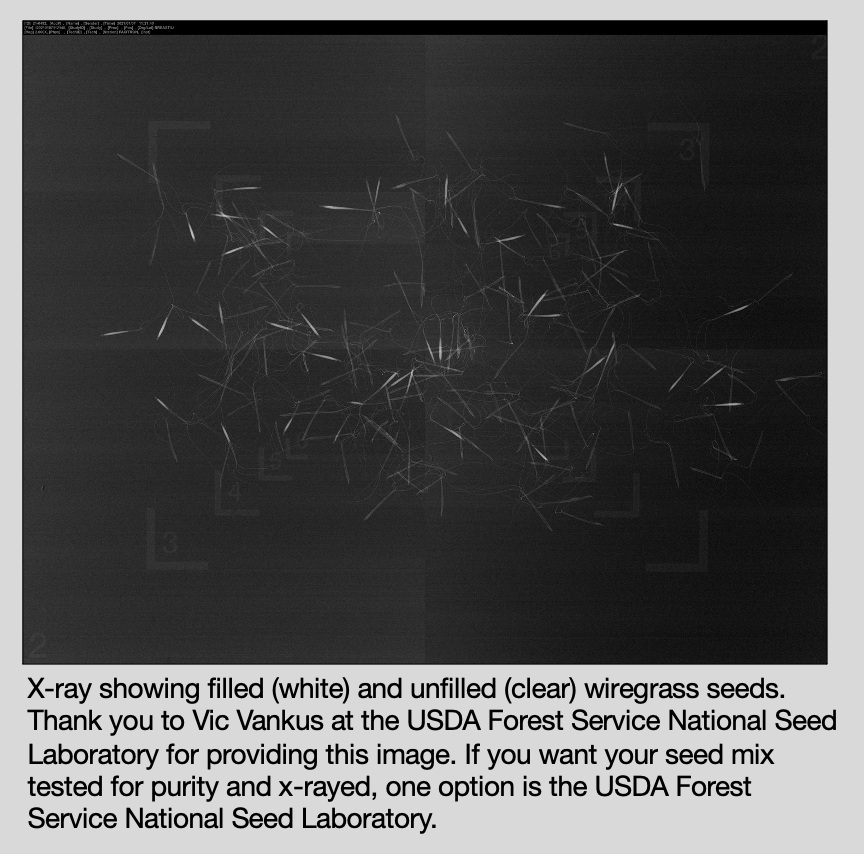Is one wiregrass seeding rate better than another?
Sometimes it seems as though the restoration process is one long series of decisions. Although we tell ourselves we’re making educated guesses based on past experiences and expert advice, it really feels like we’re trying to pin a tail on a donkey while blindfolded in a room with no donkey! Never has this felt truer in our restoration journey than now as we ponder the question of seeding rates. We have proposed to test three wiregrass seeding rates, but what is an ecologically meaningful or realistic rate? How do we even go about making this decision?
Well first, we had to GET seeds!
This step turned out to be surprisingly difficult. The weather conditions (and probably COVID) at the very least, had interrupted fire operations such that our options for local seed sources were very limited. We also needed seed from sites that were hydrologically different. We don’t know what we would have done without the incredibly helpful suggestions and assistance of folks dedicated to supporting restoration projects (it really all came together at the eleventh hour after emails and calls to many people!).
Logistics resulted in different collection methods for the seeds from each site. The flail vac (see photos below) moves over the top of all plants in an area, sweeping seeds into its hopper using brushes and a vacuum. There are a couple of advantages to using a flail vac. First, you’re probably collecting seeds of many other species along with the wiregrass seeds (diversity!), and second, it’s far less labor intensive. With hand collection, the culms with seeds are cut at the base of the plant- by hand- and then the seeds are stripped off the culms- by hand- which means… a lot of work!! It also means that much of the chaff (glumes, lemmas, and small pieces of stem) are collected too. We have found a slightly faster (…and slightly dangerous) way to strip seeds from hand-collected culms, which we might share in a future post. For our project, seeds at the dry site were collected with a flail vac and those at the wet site were hand-collected.
How much of what you collect is actually wiregrass seeds?
In a study reported by Vaughan (2001), in which seeds were collected by flail vac, between “10 and 21 percent of the weight of a full bag contained wiregrass seed”. Apalachicola Bluffs and Ravines Preserve has found that the quality of seeds varies by year; anywhere from 6-44% of seeds are viable (could germinate under optimal conditions) in a given year. Keep in mind that the germination rate depends on a lot of things beyond the quality of wiregrass seeds, including weather and soil conditions at your site, so it is unlikely that field germination would ever match what is attained in the lab or predicted in tests. Our dry seed is 50.73% wiregrass and 33% of the seeds are filled according to x-ray analysis. It is fairly common to x-ray seeds and use that as an estimation for seed viability. The seed hand-collected from the wet site is 44.5% wiregrass and 54% of the seeds are filled.
What seeding rate is recommended? If we go to the literature and experiences of others, the answer varies. Walker and Silletti (2006) reported that “56 kg/ha of material that is 10–11% wiregrass seed by weight” was recommended if the goal was three wiregrass plants or more per meter squared. That means planting 50 pounds of “material” per acre. In a good year, I cannot imagine having that much to plant! Others have suggested 2-2.5 pounds per acre (Walker 1999 and references therein) or 5-10 lbs/acre (C. Kinslow, personal communication; Cox et al. 2004; Trusty & Ober 2009).
What seeding rate should you use? The answer depends on what you have and your goal. Sometimes money or logistics limit the available options, and the answer is: whatever you can! The amount and viability of wiregrass in your collected material is certainly going to affect the outcome and will vary each year. If it’s possible to have your seed mix tested, it would be extremely informative for both planning and sharing your results with others!
What seedling rates did we choose (or more accurately, what seeding rate chose us)?
We were definitely faced with a struggle of logistics! So, we decided to plant the seeds from our wet and dry sites at 6.5 and 6.6 lbs/acre, respectively, because that is how much seed we were able to get, while reserving some for other treatment plots at 10 and 12 lbs/acre. Our dry seeds had slightly lower filled seeds per pound, so we are slightly compensating for that.
Despite the uncertainty, the seeding rate that “chose us,” is still within the range that has been recommended, and our research will still meet its goal of showing whether higher planting densities improve wiregrass establishment.
This week our seeds will be planted, so the next blog will highlight that process. In the meantime, we will be carrying around some little reminders of hand stripping wiregrass seeds for a very long time!
References
Cox, A.C., D.R. Gordon, J.L. Slapcinsky, and G.S. Seamon. 2004. Understory restoration in longleaf pine sandhills. Natural Areas Journal, 24, 4-14.
Trusty, J.L., and H.K. Ober. 2009. Groundcover restoration in forests of the Southeastern United States. CFEOR Research Report 2009-01. University of Florida, Gainesville, FL. 115 pp.
Vaughan, E. 2001. The Apalachicola Bluffs and Ravines Preserve in Northern Florida: a longleaf pine and wiregrass restoration project. Restoration and Reclamation Review 7, 1-10.
Walker, J.L., and A.M. Silletti. 2006. Restoring the ground layer of longleaf pine ecosystems. P. 297–325 in The Longleaf Pine Ecosystem: Ecology, Silviculture, and Restoration, Jose, S., E.J. Jokela and D.L. Miller (eds.). Springer, New York.






